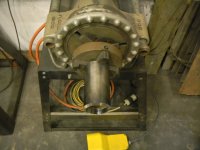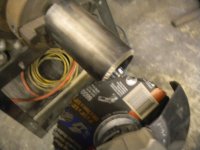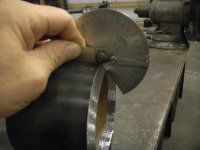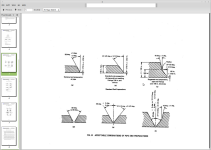You are using an out of date browser. It may not display this or other websites correctly.
You should upgrade or use an alternative browser.
You should upgrade or use an alternative browser.
Rod size, type and best way to weld suggestion
- Thread starter kneedeep
- Start date
/ Rod size, type and best way to weld suggestion
#11
Farmerford
Platinum Member
- Joined
- Dec 9, 2006
- Messages
- 733
- Location
- Columbus, Georgia
- Tractor
- Kuborta B2400, L2900, L4330; Caterpillar D3B, John Deere 455D
Shield Arc:
I wondered at first if maybe the last two pictures were the back side of your weld, but I decided not because I could not imagine such a smooth bead on the inside of the pipe. And you say you are not a pipe welder?
Do the back sides of your structural butt welds look like that?
Are you able to tell enough while you are welding to know how the backside of the weld pool is looking, or do you just have to learn from experience the bevel angle, root face, root gap, rod size, speed, amps, arc distance, etc. that will produce the desired result?
I did not want to question the 65-70 amps you recommended for 1/8 6010 because I have no experience. But the MIller chart that shows 75-115 amps, and I have trouble maintaining an arc in the lower part of the range. I probably don't have enough years left to learn to use the rod at 65 amps! Is that amperage how you keep from blowing out the back side?
Thanks again for your help.
I wondered at first if maybe the last two pictures were the back side of your weld, but I decided not because I could not imagine such a smooth bead on the inside of the pipe. And you say you are not a pipe welder?
Do the back sides of your structural butt welds look like that?
Are you able to tell enough while you are welding to know how the backside of the weld pool is looking, or do you just have to learn from experience the bevel angle, root face, root gap, rod size, speed, amps, arc distance, etc. that will produce the desired result?
I did not want to question the 65-70 amps you recommended for 1/8 6010 because I have no experience. But the MIller chart that shows 75-115 amps, and I have trouble maintaining an arc in the lower part of the range. I probably don't have enough years left to learn to use the rod at 65 amps! Is that amperage how you keep from blowing out the back side?
Thanks again for your help.
Shield Arc
Super Member
Open root pipe welding is done a lot by sound. I've seen real pipe weldors not even look at the root pass while it was going in. Some pipe weldors will look you right in the face and carry on a conversation with you while putting in the root pass.
I've welded a lot of pipe, but they were piling. 99.9 % of the time they had a chill ring inside. I think the smallest I ever did was 12-inch, the biggest 10-feet. The pipe in 2-G, (vertical pipe, horizontal weld) in my mind this is not pipe welding! Only open root pipe welding I ever did was in the testing booth. Yes they test structural weldors on pipe. Pipe welding separates the men from the boys in short order!
Far as the amps, remember there is not very much volume of metal when doing open root pipe. I'm sure a real pipe weldor like Gary Fowler could up my amps numbers by 50%!
I've welded a lot of pipe, but they were piling. 99.9 % of the time they had a chill ring inside. I think the smallest I ever did was 12-inch, the biggest 10-feet. The pipe in 2-G, (vertical pipe, horizontal weld) in my mind this is not pipe welding! Only open root pipe welding I ever did was in the testing booth. Yes they test structural weldors on pipe. Pipe welding separates the men from the boys in short order!
Far as the amps, remember there is not very much volume of metal when doing open root pipe. I'm sure a real pipe weldor like Gary Fowler could up my amps numbers by 50%!
Mark @ Everlast
Advertiser
As I understand it, this is not going to be a high pressure pipe, and used as drain? Depending though on the amount of water behind it, it could carry a good bit of pressure still...but it won't dead head if the gate is on the reservoir side. This job is a job not dissimilar to pipeline welding, and is a little more challenging in some respects than 6" pipe...and a little less in others. This pipe will test your ability to be consistent. I'd love to help you weld it up but I'm over in S. GA, though in a couple weeks I'll be heading over to the Mobile area for Thanksgiving. Depending upon where you are, if its' not too far, I might be able to throw a hand your way.
It'll matter what angle once you start welding it back in because it'll require more passes to fill. For something like this since you don't have a pipe beveling machine, a bevel gauge set to 30-35 degrees is sufficient. Two 37.5 degrees would give you a total of 65 degree bevel groove. A 60 will work as well. A 45 will make you wish you had a 60 degree one. This isn't rocket science but it needs to be sound, no doubt.
It'll matter what angle once you start welding it back in because it'll require more passes to fill. For something like this since you don't have a pipe beveling machine, a bevel gauge set to 30-35 degrees is sufficient. Two 37.5 degrees would give you a total of 65 degree bevel groove. A 60 will work as well. A 45 will make you wish you had a 60 degree one. This isn't rocket science but it needs to be sound, no doubt.
IslandTractor
Super Star Member
- Joined
- Sep 15, 2005
- Messages
- 17,101
- Location
- Prudence Island, RI
- Tractor
- 2007 Kioti DK40se HST, Woods BH
As I understand it, this is not going to be a high pressure pipe, and used as drain? Depending though on the amount of water behind it, it could carry a good bit of pressure still...but it won't dead head if the gate is on the reservoir side. This job is a job not dissimilar to pipeline welding, and is a little more challenging in some respects than 6" pipe...and a little less in others. This pipe will test your ability to be consistent. I'd love to help you weld it up but I'm over in S. GA, though in a couple weeks I'll be heading over to the Mobile area for Thanksgiving. Depending upon where you are, if its' not too far, I might be able to throw a hand your way.
It'll matter what angle once you start welding it back in because it'll require more passes to fill. For something like this since you don't have a pipe beveling machine, a bevel gauge set to 30-35 degrees is sufficient. Two 37.5 degrees would give you a total of 65 degree bevel groove. A 60 will work as well. A 45 will make you wish you had a 60 degree one. This isn't rocket science but it needs to be sound, no doubt.
Is the only reason not to exceed 37.5 so that you don't need to put in extra fill. I presume the reason for at least 37.5 is so you have a minimum V of 75 degrees and that assures the rod/wire can penetrate to the bottom of the V on the root pass. Is that the main reason for the universal 37.5 bevel? In a non shop field situation, would you prefer to make the bevel too big (>38 degrees) or too small?
Mark @ Everlast
Advertiser
Correction, you are right, 75. My math didn't add up...or at least my fingers weren't cooperating with my brain...
As far as what side to err on, I think it'd depend upon the application. You definitely don't want to put too much heat into it in a technical sense.
As far as what side to err on, I think it'd depend upon the application. You definitely don't want to put too much heat into it in a technical sense.
Shield Arc
Super Member
More than one way to skin a cat. 
Pipe Welding and How to Pass a SMAW 6G (open root) Pipe Welding Certification
Pipe Welding and How to Pass a SMAW 6G (open root) Pipe Welding Certification
Arc weld
Veteran Member
Downhand welding with 6010/6011 is probably 3 to 4 times faster than uphand and a lot easier to do. Don't try it with any other rods though. You can burn hotter than uphand and your beads will be flatter. It will probably take more passes to fill but still be faster. A lot easier to control penetration on the root pass. With 6010 you can use a slight whipping motion or just run it hot and and kind of drag the puddle down. That's how pipelines are welded. The idea of the bevel is to have a wide enough space to get the rod in to achieve full penetration. Your job isn't critical but imagine if you just left the pipe square and butted it together with just one pass. You wouldn't have anywhere near the strength of the pipe.
IslandTractor
Super Star Member
- Joined
- Sep 15, 2005
- Messages
- 17,101
- Location
- Prudence Island, RI
- Tractor
- 2007 Kioti DK40se HST, Woods BH
[QUOTE="Arc weld;]The idea of the bevel is to have a wide enough space to get the rod in to achieve full penetration. Your job isn't critical but imagine if you just left the pipe square and butted it together with just one pass. You wouldn't have anywhere near the strength of the pipe.[/QUOTE]
I understand the basic idea behind the bevel when making a butt weld. And, it sure makes sense to have the V wide enough to insure that a welding rod can get to the bottom. I just don't understand the standard 37.5 degree bevel on each side. Is there an actual engineering rational for such precision? Seems, for example, that a narrower V might be fine if one was using a MIG welder due to the narrower wire used. And, lacking a precision protractor, it would be easier to bevel an approximately 30-45 degree angle on each piece in the field. I can understand the need for precision in welding pressure vessels or in a nuke plant but don't understand if there is a specific engineering rationale behind the 75 degree V. We certainly don't worry about 90 degree joints on outside or inside corners or on lap joints.
I understand the basic idea behind the bevel when making a butt weld. And, it sure makes sense to have the V wide enough to insure that a welding rod can get to the bottom. I just don't understand the standard 37.5 degree bevel on each side. Is there an actual engineering rational for such precision? Seems, for example, that a narrower V might be fine if one was using a MIG welder due to the narrower wire used. And, lacking a precision protractor, it would be easier to bevel an approximately 30-45 degree angle on each piece in the field. I can understand the need for precision in welding pressure vessels or in a nuke plant but don't understand if there is a specific engineering rationale behind the 75 degree V. We certainly don't worry about 90 degree joints on outside or inside corners or on lap joints.



